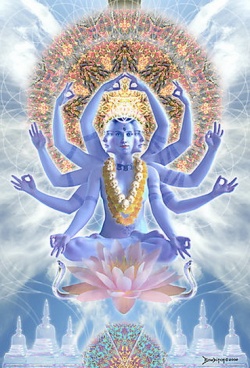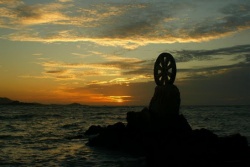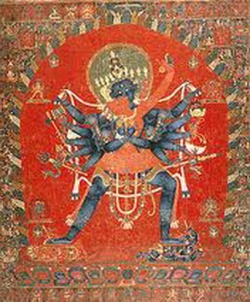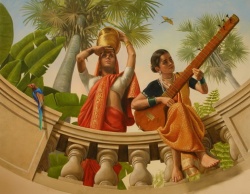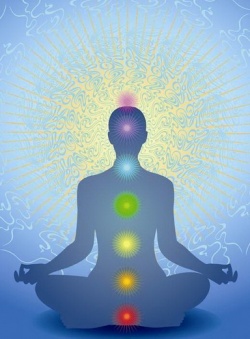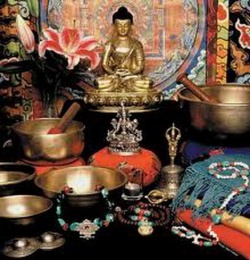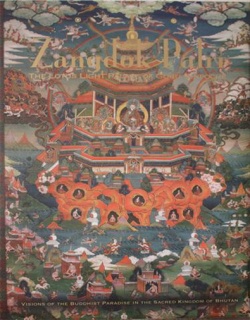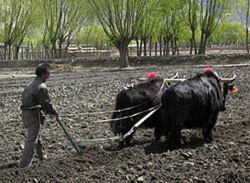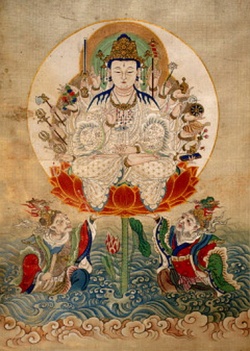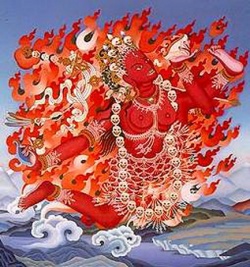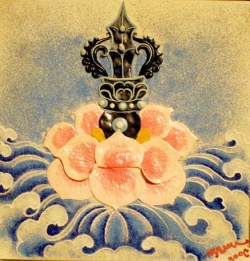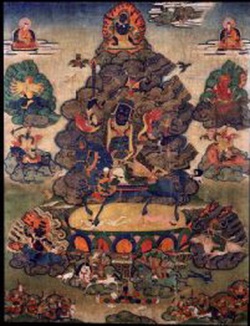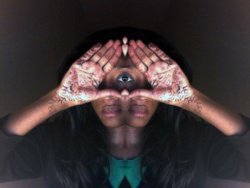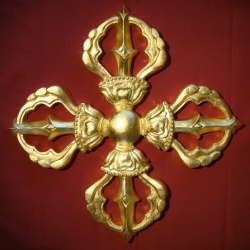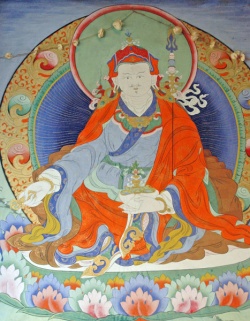Psychedelics & Buddhism
by Rick Fields
Rick Field's books include How the Swans Came to the Lake (Shambhala Publications), The Code of the Warrior (Harper Collins), Instructions to the Cook, and mostly recently before his death, Fuck You Cancer. He was the editor of Yoga Journal for many years. He died in 1999 in Fairfax, California and is survived by his wife Marsha Cohen, who gave me this article first published in Tricycle Review.
THE WAR on at least one drug, the psychedelic variety, has been won. In place of the alchemicals that reigned supreme for a momentarily eternal moment, young would be mind explorers now take their way through a fractioned marketplace of pot, coke, weak acid, heroin, cocaine, 'ludes, Ecstasy, speed, crack Set and setting? The set is the fresh curious wary jumpy insecure brain of a bright young kid, fourteen, twelve, ten, the age keeps dropping, and the setting is the school yard, the street corner, the stall in the boys' or girls' room before homeroom. Or maybe (at best?) it's a tribal merge at a thumping, flashing rave or a Grateful Dead concert. Always a buzzing swarm. But still hardly the contemplative gardens or paisley candlelit retreats of the first psychedelic illuminati. The heady halcyon days and nights of psychedelia, which once led so many to Buddhist practice, have been efficiently eliminated, reduced to retrofashion. The young now turn on in a world in which the sacred has been trivialized into the recreational. No wonder so many are relieved to see Buddhism as a recovery program: in the morning a half hour of meditation in a halfway house.
That practice can be helpful. even lifesaving, to the strung out is of course good news. But there is another sort of good news, for some unreformed heads at least. There is something of a psychedelic revival going on these days - and more than a few Buddhists are taking part in it. The sacramentals are partly the old familiar (LSD),the new (Ecstasy and other designer drugs), and the ancient (plant entheogens such as mushrooms, peyote cactus, and the Amazonian ayahuasca). Interestingly, it is the last category; the ancient plants used by the oldest indigenous peoples on the earth, that seems to hold the most promise for the future.
There are a number of reasons for this psychedelic revival. For one thing, psychedelics have proven to have a certain staying power. Stamped down countless times, abandoned for various reasons, they nevertheless somehow manage to pop up like mushrooms from one generation to the next. Timing is also a part of it. A dynamic back and forth relationship between psychedelics and Eastern spirituality has existed since the nineteenth century. In the fifties Buddhists and Hindu texts inspired aristocratic British exiles like the writers Gerald Heard and Aldous Huxley to seek an experiential illumination through psychedelics. In the sixties the same psychedelic experience inspired American academicians like Timothy Leary and Richard Alpert (Ram Dass) to investigate Eastern texts and practices.
During the eighties the use of MDMA (Adam, Ecstasy) became fashionable, both among psychotherapists and in the new youth culture in the rave and dance club scene. Ecstasy is not a hallucinogen or entheogen, but has best been described as an empathogen: it seems to relax the stranglehold of the individual ego and open the way to an unusually high level of intimacy and communication (hence its popularity with marriage counselors). The general calmness, serenity and spaciousness of the experience has led, in some circles, to its being called the "Buddha-drug." If psychedelics correspond (for some at least) with Tibetan or tantric Buddhism, then Ecstasy could be seen as the Mahayana or bodhisattva drug of choice. In fact, at least one rumor tells of a serious circle of practitioners who use Ecstasy as a support for their metta (loving-kindness) practice.
During the seventies and eighties, psychedelic drug use seems to have been largely discounted in Buddhist communities, as it was in the larger culture, though it was not entirely absent from either arena. It simply went underground. Buddhist groups quite understandably were anxious to stay on the right side of the law and seemed as anxious as most organizations to separate themselves from the sixties' drug and antiwar countercultures. And individual students were growing older, taking on the responsibilities of families and careers. For most students psychedelics were remembered as a boat that had gotten them to the other shore of real practice but was now a distraction to be abandoned.
But just as in the larger culture, a small number of students continued to experiment with psychedelics when they were off duty, in the "post meditation state." Most of these, perhaps, fell into the post sixties fashion of using psychedelics for largely recreational reasons. A loosely floating post hippie tribe of Buddhist Deadheads, the Dead Buddhists of America, kept some thing of the old spirit alive. When Jerry Garcia died in 1995, the editor of their 'zine, The Conch Us Times, led a meditation of Chenrezi, the bodhisattva of compassion. In the middle of the meditation, he instructed everyone to see Jerry as the bodhisattva, 'merging with the lights of Buddha-mind in the journey through the bardos."
Now, in the pre-millennium nineties, we may be seeing a generation who have steeped themselves in practice become inspired to take another, more mature, and more penetrating, look at psychedelics.
DURING THE SOPORIFIC FIFTIES, access to both psychedelics and Buddhism was limited to a small but influential elite. A British psychiatrist working in Canada, Dr. Humphrey Osmond. enlisted Aldous Huxley as a subject for his experiments with mescaline in Los Angeles one afternoon in the middle of May 1953. Huxley was well prepared. He and his fellow expatriate, the writer Gerald Heard, had studied Vedanta and practiced disciplined meditation for so me years, and Huxley had ransacked the world's mystical writings for his anthology The Perennial Philosophy Sitting in his garden with Dr. Osmond, he experienced the grace and transfiguration he had read about. Remembering a koan from one of D. T. Suzuki's essays, 'What is the Dharma Body of the Buddha?" he found the answer: 'The hedge at the bottom of the garden." What had previously seemed "only a vaguely pregnant piece of nonsense" was now clear as day "Of course, the Dharma Body of the Buddha was the hedge at the bottom of the garden," he reported in The Doors of Perception. 'At the same time, and no less obviously, it was these flowers, it was anything that I, or rather the blessed Not I, released for a moment from my throttling embrace, cared to look at." Of course Huxley still had his famous wits about him. 'I am not so foolish as to equate what happens under the influence of mescaline . . . with the realization of the end and ultimate purpose of human life: Enlightenment." he reassured his reader. "All I am suggesting is that the mescaline experience is what Catholic theologians call a gratuitous grace.' not necessary to salvation but potentially helpful and to be accepted thankfully, if made available." When Maria. Huxley's wife of more than thirty years, lay dying of cancer he read to her the reminders from The Tibetan Book of the Dead, reducing them to their simplest form and repeating them close to her ear: 'Let go, let go. Go forward into the light. Let yourself be carried into the light." He continued after she had stopped breathing, "tears streaming down his face, with his quiet voice not breaking," his son Matthew remembered.
A few years earlier, in July 1953, the ex banker ethnomycologist Gordon Wasson and his wife, Valentina, had reached the Mazatec village of Huautla de Jimenez, where they discovered the magic psilocybin mushrooms (teonanacatl, the 'flesh of the gods") and managed to take part in an all night velada. Wasson's even handed and respectful article on his adventures was published by Life in 1957. The article was read by a Berkeley psychologist, Frank Barron, who had tried some of the mushrooms, and passed on his enthusiasm to another academic psychologist and old friend, Timothy Leary Before taking up his new job at Harvard's Center for the Study of Personality Leary spent the summer in Cuemavaca. Naturally, he tried the mushrooms. "The journey lasted little over four hours," he wrote. "Like almost everyone who had the veil drawn. I came back a changed man."
Leary was now more interested in transcendence than personality assessment. As head of the Harvard Psychedelic Drug Research Project, he ran a session for MIT Professor Huston Smith, who made the experience available as a laboratory experiment for his seminars in mysticism. Next, in a now famous double blind experiment. On Good Friday in a chapel of the Boston University Cathedral. divinity students were given either psilocybin or a placebo. To no one's surprise only those who had taken the psychedelic sacrament reported what appeared to be bona fide mystical experiences. Time published a favorable report, with reassuring quotes from Professor Walter Clark of Andover Smith, and other leading theologians. "We expected that every priest, minister, rabbi, theologian, philosopher, scholar and just plain God seeking man, woman and child in the country would follow up the implications of the study," wrote Leary. Instead, "a tide of disapproval greeted the good news." What followed was much worse. As use spread and the less expensive and much more powerful LSD became the drug of choice, all heaven and hell broke loose. Huxley, guest lecturing at MIT, advised discretion, keeping the drugs inside a small, charmed circle, a kind of aristocratic mystery school. Leary put forth a plan for training and certifying guides. But it was all too much, too fast, and too late. A generation gap had been blown open. The old were appalled, the young enthralled. "Some students quit school and pilgrimage eastward to study yoga on the Ganges," Leary wrote in Flashbacks, "not necessarily a bad development from our point of view but understandably upsetting to parents. who did not send their kids to Harvard to become buddhas."
Leary and Alpert left Harvard in 1963. Now they were but one wave, albeit a very visible and noisy one, in a counterculture transformation that had swept across America and crested in San Francisco. The center of activity was Haight Ashbury, which was just a short stroll from a Soto Zen mission, Sokoji, and its American offshoot, the San Francisco Zen Center But the spiritual atmosphere was more than Zen, it was eclectic, visionary, polytheistic, ecstatic and defiantly devotional. The newspaper of the new vision, The San Francisco Oracle, exploded in a vast rainbow that encompassed everything in one great Whitmanesque blaze of light and camaraderie. North American Indians, Shiva, Kali, Buddha, tarot, astrology, Saint Francis, Zen, and tantra all combined to sell fifty thousand copies on streets that were suddenly teeming with people. When the Oracle printed the Heart Sutra, it presented a double spread of the Zen Center version complete with Chinese characters, but also with a naked goddess, drawn in the best Avalon Ballroom psychedelic. While the beats had dressed in existential black and blue, this new generation wore plumage and beads and feathers worthy of the most flaming tropical birds. If the previous generation had been gloomy atheists attracted to Zen by iconoclastic directives, i.e., If you meet the Buddha, kill him, these new kids were, as Gary Snyder told Dom Aelred Graham in an interview in Kyoto, 'unabashedly religious. They love to talk about God or Christ or Vishnu or Shiva."
Snyder himself had gotten a firsthand look at the counterculture when he retimed from Japan for a short visit in 1966. He was just in time for the first Be In at Golden Gate Park, where he was joined by a number of friends from the early days. Allen Ginsberg was there, as were Lawrence Ferlinghetti and Michael McClure. Kerouac was conspicuous by his brooding absence. He wanted nothing to do with it all. (When Leary had offered him LSD back in Ginsberg's apartment in New York he had objected: "Walking on water wasn't built in a day.") These new hippies horrified him. When a bunch of kids showed up at his mother's house in Northampton, Long Island, with jackets that said "Dharma Bums" across the back, he slammed the door in their faces.
But now, at the Be In, with the sun shining through a deep blue sky and thousands of people at ease in all their finery on the meadow, Snyder read his poems and Ginsberg chanted the Heart Sutra to clear the meadows of lurking demons. Even Shunryu Suzuki Roshi of the burgeoning San Francisco Zen Center appeared briefly, holding a single flower.
Also present on the stage that afternoon were Timothy Leary and Richard Alpert, the two ex Harvard psychology professors. who by now were prophetic psychedelic pied pipers. Whatever else LSD became in time, at that moment it was the messenger that led a fair number of people into the dazzling land of their own mind. What had begun as the private discovery of a few intellectuals and experimenters had spread in a flash. and for a split second of history it was as if the veil had been rent and all the archetypes of the unconscious now sprang forth.
There were those who claimed that psychedelics had changed the rules of the game, and that the mystic visions once enjoyed only by saints could now be had by anyone. In any case, it was obvious to the university researchers at Harvard, who had searched the scientific literature in vain, that the scriptures of Buddhism (and Hinduism) contained descriptions that matched what they had seen and felt. So Timothy Leary recast the verses of the Tao Te Ching in a book called Psychedelic Provers, and in 1962 Timothy Leary, Ralph Metzner, and Richard Alpert adapted the Bardo Thodol, The Tibetan Book of the Dead retranslated from Evans-Wentz's Anglo-Buddhist to American Psychedelic" in The Psychedelic Experience: A Manual Based on the Tibetan Book of the Dead. Because the book was apparently meant to acquaint a dying person with the liberation of the Clear Light of Reality and then guide him or her through the peaceful and wrathful deities of the bardo it was fairly easy to recast it as a guide in which physical death was reconfigured as the death of the ego during a psychedelic trip. The Psychedelic Experience went through sixteen editions and was translated into seven languages.
One of the books most interested readers was Aldous Huxley, who called Leary from Los Angeles, where Huxley was now dying of cancer. When Leary flew our to see him. Huxley asked him to guide him through the bardos. Leary suggested that it would be better if Huxley's second wife, Laura, guided the sessions. "No, I don't want to put any more emotional pressure on her.' Huxley replied. I plan to die during the trip, after all.' In the end. Laura did give him the sacrament (LSD) and read him the instructions from the Tibetan Book of the Dead. And so Aldous Huxley passed peacefully into the Clear Light of Reality.
Before long, a number of the psychedelic luminaries made their way to India. In 1966. Ralph Metzner introduced Timothy Leary to the German born Lama Anagarika Govinda, who lived in Evans-Wentz's old cottage in the Himalayan village of Nanital. "The lama had been most impressed to learn that The Psychedelic Experience contained a dedication to him." Leary wrote in Flashbacks. Govinda had requested an LSD session which Metzner provided. For the first time, after thirty years of meditation, the lama had experienced the Bardo Thodal in its living sweating reality. According to Leary, Govinda told him that "many of the guardians of the old philosophic traditions had realized that the evolution of the human race had depended upon restoration of unity between the outer science advanced by the West and the inner yoga advanced by the East." The teachings of Theosophy, Gurdjieff, Ramakrishna, Krishnamurti, and Evans-Wentz's translation of the Tibetan Book of the Dead had all been part of this plan. "You," the lama told Leary, "are the predictable result of a strategy that has been unfolding for over fifty years. You have done exactly what the philosophers wanted done." Presumably referring to Gerald Heard and Huxley, he said, "You were prepared discreetly by several Englishmen who were themselves agents of this process. You have been an unwitting tool of the great transformation of our age.
Ginsberg arrived in India that same year. Lately his psychedelic visions had become frightening, and he was wondering if he ought to continue. In Kalimpong he visited Dudjom Rinpoche, the great yogi scholar who was head of the Nyingma (Ancient Ones) lineage. "I have these terrible visions, what should I do?" he asked. Dudjom Rinpoche sucked air through his mouth, a traditional Tibetan sign of sympathy, and said, "If you see anything horrible, don't cling to it; if you see anything beautiful, don't cling to it."
Leary's partner, Richard Alpert (now known as Ram Dass), reached India in 1967, "hoping to find someone who might understand more about these substances than we did in the West." When he met his guru, Neem Karoli Baba, Ram Dass gave him a hefty dose of nine hundred micrograms. "My reaction was one of shock mixed with the fascination of a social scientist, eager to see what would happen," Ram Dass wrote.
"He allowed me to stay for an hour, and nothing happened. Nothing whatsoever He just laughed at me."
Another time the old man swallowed a mind boggling twelve hundred micrograms. "And then he asked, 'Have you got anything stronger?' I didn't. Then he said, 'These medicines were used in Kulu Valley long ago. But yogis have lost that knowledge. They were used with fasting. Nobody knows how to take them now To take them with no effect, your mind must be firmly fixed on God. Others would be afraid to take. Many saints would not take this 'And he left it at that " (From Miracle of Love, Stories about Neem Keroli Baba, by Ram Dass.)
Of course, the voyage was not always necessary In his essay "Passage to More than India," Gary Snyder wrote, "Those who do not have the time or money to go to India Japan, but who think a great deal about the wisdom traditions, have remarkable results when they take LSD. The Bhagavad Gita, the Hindu Mythologies, the Serpent Power, the Lankavatara Sutra, the Upanishads, the Hevajra Tantra, the Mahanirvana Tantra, to name a few texts, become, they say, finally clear to them. They often feel that they must radically reorganize their lives to harmonize with such insights." At times, as Snyder noted, the psychedelic experience led straight to meditation. "In several American cities," he wrote, "traditional meditation halls of both Rinzai and Soto are flourishing. Many of the newcomers tuned to traditional meditation after initial acid experience. The two types of experience seem to inform each other".
It was impossible for any Roshi to ignore the question of LSD and its relationship to Buddhism. Koun Yamada Roshi, Yasutani Roshi's chief disciple in Japan, was said to have tried it only to report, "This isn't form is the same as emptiness; this is emptiness is the same as form." If Suzuki Roshi said (as Gary Snyder told Dom Aelred Graham) that "people who have started to come to the zendo from LSD experiences have shown an ability to get into good zazen very rapidly," he also said in New York (as Harold Talbort, Graham's secretary, told Snyder) "that the LSD experience was entirely distinct from Zen." In any case, it seemed that in practice Suzuki Roshi mostly ignored it. When Mary Farkas of the First Zen Institute asked him what he thought of the "Zen drug tie up we kept hearing so much of" she gathered from his reply "that students who had been on drugs gradually gave them up and that highly structured and supervised activities left little opportunity and lessened inclination."
But not everyone was so tolerant. In New York a student walked into the zendo on acid, sat on his zafu until he felt enlightened enough to get up off his cushion in the middle of zazen, then knelt in front of the teacher, Eido Roshi, rang the bell, and walked off non chalantly into the small rock garden in back of the zendo. Eldo Roshi followed, and the two stood locked eyeball to eyeball, until the teacher asked, 'Yes, but is it real?" and the student, who seemed to have held his own till then, fled. After that, there was a rule that no one could sit zazen who used LSD in or out of the zendo.
Others in the Zen world were equally concerned. In Japan, D. T Suzuki wrote an essay as part of a symposium on "Buddhism and Drugs" for The Eastern Buddhist, in which he warned that the popularity of LSD "has reached a point where university professors organize groups of mystical drug takers with the intention of forming an intentional society of those who seek 'internal freedom. .....All this sounds dreamy indeed," wrote D. T Suzuki, "yet they are so serious in their intention, that Zen people cannot simply ignore their movements.
If Dr. Suzuki sounded the alarm, the Americans were more moderate in their reactions. Ray Jordan, a former student of Nyogen Senzaki's and then an assistant professor of psychology, had written in Psychologia that "LSD might be a useful aid both to the realization of prajna (wisdom), and to the development of meditational practice." but a sesshin with Yasutani-roshi had since convinced him that he had been mistaken. The sesshin had "included a moment which the Roshi identified as kensho," and Jordan was now able to testify that even the deepest and most powerful realizations associated with LSD were weak and dim compared to the reality and clarity of sesshin events." Jordan admitted that "in a small number of cases psychedelic experiences may have revealed to persons the everyday presentness of the Pure Buddha Land [but] from that point on the psychedelics are of no value whatsoever insofar as the Way is concerned. Without relying on anything one must walk step by step, moment by moment in the daily reality of the Pure Land."
Alan Watts was more sympathetic. He pointed out, to begin with, that everybody must speak for himself since so much depended on the "mental state of the person taking the chemical and circumstances under which the experiment is conducted." In Watts's case, these had been benign, and LSD had given him "an experience both like and unlike what I understood as the flavor of Zen." His mind had slowed, there were subtle changes in sense perception, and most importantly, "the thinker" had become confounded so that it realized "that all so called opposites go together in somewhat the same way as the two sides of a single coin." This in turn had led to an experience of what the Japanese Buddhists called ji ji-mu-ge, the principle of universal interpenetration.
But if one were not trained in yoga or Zen, warned Watts, this insight might lead one to believe either that "you are the helpless victim of everything that happens to you," or that, like God, you are 'personally responsible for everything that happened." To go beyond this impasse, one needed either "an attitude of profound faith or letting-go to you-know-not-what." In that case, "the rest of the experience is total delight ... what, in Buddhist terms, would be called an experience of world as dhamadhatu, of all things and events, however splendid or deplorable from relative points of view, as aspects of symphonic harmony) which, in its totality, is gorgeous beyond belief."
And yet, the most interesting part of the experience for Watts was nor this ecstatic and sublime state, but the moment of return to the ordinary state of mind. There "in the twinkling of an eye" lay the realization "that so-called everyday or ordinary consciousness is the supreme form of awakening. of Buddha's anuttara-sanryak-sambodhi." But this realization, remembered clearly enough, soon faded. "It is thus," concluded "that many of us who have experimented with psychedelic chemicals have left them behind, like the raft which you used to cross a river and have found growing interest and even pleasure in the simplest practice of zazen, which we perform like idiots, without any special purpose.
It was left to Robert Aitken to describe the new psychedelic influenced generation in detail. The early members of Koko-an Zendo, Aitken remembers, were former Theosophists. The turning point had come in 1963 or 1964 when utter strangers would come into the dojo. how at the entrance, seat themselves and sir like stones through the first period, and then at kinhin (walking meditation) time they would get up and fall down."
Aitken couldn't figure it out, until he later discovered that word had gone out that the Koko-an Zendo was a good place for tripping.
In 1967 the Aitken bought a house on the island of Maui in anticipation of Robert's retirement from the East-West Center at the University of Hawaii. The long-haired young had begun to flock to Maui by then, and many of them had rented rooms in the Aitken house. Those from "the tragic end of the counterculture," he wrote in The Eastern Buddhist, "had a consuming interest in illuminative religion, a sense of wholeness and essence, a love of nature. a devotion to poverty and asceticism, a sensitivity to one an another and a desire to 'get it on,' that is, to practice rather than simply to talk."
Many of these were interested in zazen, and the Aitken decided to establish a branch of Koko-an on Maui. In its first stages, Maui Zendo served "as a kind of mission to the psychedelic Bohemia." "Virtually all the young people who knock on our front door have tried LSD, mescaline, or psilocybin," he wrote, a situation that he thought true for the San Francisco Zen Center as well as other groups across the country.
The Maui Zendo soon became known as "a place where you could get your head together." and a regular zazen schedule was begun. But the turnover was enormous. "The thing that created this marvelous spirit also destroyed it." Aitken says now and that was the dope." The regular use of marijuana, Aitken had observed, "destroyed the sense of proportion," while LSD, as he had written in his essay, seemed to "shatter much of the personality structure, and the impulse of the moment assumed paramount importance."
It was, finally, the "human problem of distraction" that Aitken found most crucial. "The new gypsies," he found, "blow like leaves in the wind, now in Mendocino, now at San Francisco, then all the way to Maui, then back to the mainland. always with a convincing reason that may be no more than a faint interior or exterior impulse." Zazen as a natural corrective to this, and the Maui Zendo began to develop more and more in the direction of a training center.
If the sixties was a high point of the Zen generation, the seventies belonged to the Tibetans. The proximate cause, of course, was the Tibetan diaspora. But the hallucinogenic aspect of the psychedelic experience itself was certainly a contributing factor. The visual pyrotechnics of psychedelia made a close fit with the colorful flamboyance of the radiant gods and goddesses and fiery deities of Tibetan art. The putative correspondence was further strengthened by seeming similarities between the visionary experience of the most popular Tibetan text of the sixties, the Bardo Thodal or Tibetan Book of the Dead, and the psychedelic experience. These elements of psychedelia had their part to play in the increasing popularity of Tibetan Buddhism. But as most would-be practitioners soon discovered, the first wave of lamas were more interested in students who were willing and able to engage in a series of demanding practices. The point was not to have visions, but to visualize.
Another point of divergence was that many people had hoped that meditation and yoga would provide the permanent high" lacking in psychedelics. But as more people actually threw themselves into the practice, it tuned out that practice was not really about getting high at all. In Buddhism, at least, the instructions seemed to be to not cling to any experience, high or low. A fragment from a Gary Snyder poem springs to mind: "Experience that drug......."
With the advent of actual practice came Buddhist critique of the psychedelic experience. Some teachers slotted drugs into the mind intoxicant category of the precepts. This was not really convincing for many, however, because whatever psychedelics might be, anyone who had taken them knew that "intoxicating" was a limited, reductionistic description, at best. And more often than nor, the Asian teachers making such pronouncements had no actual experience of psychedelics.
The few teachers who did have such experience, however, were in a uniquely privileged position to compare the two experiences. The most sympathetic of these was Trungpa Rinpoche, who had tested and tasted the splendors of Western civilization in England. He was one of the few Buddhist teachers one could talk to about such things, which many of his students, myself included, asked him about. Officially, of course, all illegal drugs were prohibited. But privately Trungpa Rinpoche had, as he told me (and here I paraphrase loosely from faulty memory), a lot of sympathy for students who had taken LSD. He even volunteered that we might take it together some time in the future, an opportunity or challenge that I never got to take him up on, to both my regret and relief. The suggestion was both exhilarating and scary. His style and skill, after all, was in cutting through trips of spiritual materialism rather than guiding them.
This is hardly surprising. More than most spiritual paths, Buddhism tends not to be very impressed by "experiences," be they spiritual or psychedelic. And Trungpa Rinpoche, for all his outwardly wild non conventional behavior, was a Tibetan mastiff when it came to practice: your ass was on the line, which meant on the cushion. Still, at least in the "early days" of the seventies, his sangha was wilder and more open than many. The point, it seemed, was not to avoid samsara but to get into it directly, as long as you returned to the cushion next morning, hungover or fried. As he said in one of his few public statements about it, LSD was a kind of "super samsara," and in as much as it heightened certain samsaric tendencies it could be a useful method.
About marijuana he was less tolerant. The main problem, he once told me, was that marijuana tended to "mimic meditation." This take led to a dramatic confrontation with a group of his earliest students. In the early seventies a tribe of hippies, known as the Pygmies, became students and were the first to colonize the undeveloped land that has since become known as Rocky Mountain Dharma Center. They cobbled together an odd assortment of living quarters, yurts, one rooms, A frames, a six sided cabin. "At night the main entertainment tended to be kicking back, pouring a beer, smoking a joint," reported Barbara Stewart about that time in The Vajradhatu Sun (August/September 1991), "but a meeting ensued, a powerful and violent clash that would eventually mean the beginning of the end of the Pygmies private
Smoking marijuana, Rinpoche said, was lying to themselves, indulging in self deception. They should bum both, marijuana and self deception... The Pygmies were taken aback, angry and confused. But only one person, call him Mike, fought back Jim Lowry remembers this scene. . 'Mike hit Rinpoche and Rinpoche hit Mike. It was violent, it was a huge eruption. Rinpoche threw a flower pot he missed Mike. Maggie screamed, 'Stop!' Rinpoche built a fire in the fireplace. 'Destroy self deception,' he was saying. It was tense but calm.... Everyone went and got dope and threw it in the fire. We were kind of chanting: 'Destroy self-deception, destroy self-deception.' . . The first dathun month long group meditation) was a turning point, confirming the obvious, that this land was to be a meditation center and not an Eden like Pygmy crafts commune
Such was the powerful antidrug drift As always, however there were counter currents. During the seventies, the eighties, and up to the present, a small number of committed Buddhist practitioners have used the sacrament in the context of formal practice. This was necessarily a secret use, harking back to the earliest tantric circles in India, where unlawful and taboo substances such as meat and wine were transformed into sacraments. This group was naturally self selecting, composed mostly of practitioners experienced in both modalities, who found that, handled properly, psychedelics can be a useful skillful means. If the practitioner has the balance and moves to surf the psychedelic waves, the argument went, then the experience can be useful in one's sadhana (formal practice) Myton J. Stolaroff, active in psychedelic research since 1960, is one of these Buddhist practitioners. "For myself" he writes in a recent issue of Gnosis, "I found training in Tibetan Buddhist meditation a potent adjunct to psychedelic exploration. In leaning to hold my mind empty, I became aware that other levels of reality would more readily manifest. It was only in absolute stillness that many subtle but extremely valuable nuances of reality appeared. While I achieved this to some extent in ordinary practice, I found this effect to be greatly amplified while under the influence of a psychedelic substance. This in turn intensified my daily practice."
Such a claim will be outrageous to many, probably most, Buddhist practitioners. After all, the use of any intoxicants is proscribed by the precepts. And while Saivite Hindu sadhus smoke ganja, and Christians drink wine, and Sufis (some at least) have been known to smoke hashish, Buddhists seem to have been a decidedly sober if not straight, square group. It's true that green tea, a powerful stimulant, is connected with Bodhidharma, and is used by Zen monks as a stimulant to ward off sleep during meditation. And alcohol also has a small hut enduring place in Buddhist practice, Zen masters have exhibited a fondness for sake, and liquor is used ceremonially in tantric feasts, while chang, a potent Tibetan barley-beer is consumed by monks and lay practitioners in tantric ceremonies (as well as for fun) throughout the Himalayas.
But what about psychedelics? Is it really the case that Buddhism, the one "major world religion" without a personal creator God, is lacking in a mind-altering or mind-opening sacrament? And even if it lacks such a sacrament today, has it always been so? Certain images in Buddhist texts suggest that this has not always been the case. The most glaring example is the existence of amrita, a drink or substance that is said to confer death-lessness or liberation. If this amtita is not an actual mind-altering substance or plant, what we would so crudely call a "drug", is it "merely" a symbol? But even if it's a symbol, that still leaves the question: a symbol of what?
This question leads back to one of the greatest explorer researcher theorists of psychedelic lore: amateur ethnomycologist Gordon Wasson, who introduced the world to the magic psilocybin mushrooms of indigenous Mexico. When Wasson extended his exploration to other cultures, most notably India, he found compelling evidence that the mysterious soma of the Vedic hymns was, in fact, an infusion made from the psychedelic mushroom amanita muscaria, or fly-agaric the sacramental basis for a shamanistic un-religion which he traced back to the late Ice Age in Siberia. Wasson had an antipathy to hippies and "Timothy Leary' and his ilk," and so was uncomfortable with the term "psychedelic." He suggested, instead, entheogenic "god generated within," for the sacred plants that he felt lay behind the mysteries of the ancients.
Wasson's line of research exemplifies an ethno botanical school of psychedelic research that was contemporaneous with, and obscured by, the sensationalistic and hysterical LSD furor of the sixties. But during the nineties this lineage of ethnobotany has continued to be enriched by gifted academic botanists, such as Schultes at Harvard, and gifted amateurs like Wasson. The most interesting of these post-Wassonites, for our purpose at least, is one Scott Hajicek-Dobberstein, who recently published a fascinating paper. "Soma siddhas and alchemical enlightenment psychedelic mushrooms in Buddhist tradition." in the Journal of Ethno pharmacology. Hajicek-Dobberstein argues that the Vedic soma cult, or something very similar to it, survived among the tantric Buddhist siddhas who lived in India from the eighth to the tenth century C.E.. and whose biographies are recounted in a twelfth-century Tibetan text, The Legends of the Eighty-four Mahasiddhas.
The most compelling evidence is found in the story of the siddha Kanaripa. His guru. Nagarjuna instructed him to demonstrate his austerity by collecting only as much food for alms as he could balance on the head of a needle. Kanaripa returned with a large pancake balanced on the tip of a needle, a symbol, suggests Hajicek-Dobberstein, of the amanita muscaria. More symbols are suggested. but the most convincing evidence is an exchange in which Nagarjuna says. "We need to eat the alchemical medicine." Kanaripa does so, and then spreads his spittle on a dead tree, which bursts in blossom, and then urinates in a pot. This behavior is taken as a sign of realization by Kamaripa's teacher For Hajicek-Dobberstein, it is a "marker" of the presence of amanita soma because drinking the urine of a shaman who has consumed amanita intensifies the potency of the mushroom and is a well-known practice among Siberians.
The possible use of amanita (or other mushrooms or plants) by siddhas also offers a possible solution to two thorny Tibetan etymological puzzles. The Tibetan name for cannabis, So.Ma.Ra.Dza. from the Sanskrit soma-raja, or "king of soma" can now be read as a linguistic trace of a long forgotten tradition. The second puzzle involves the Tibetan translation of amrita (deathless) as bDud.rTsi. The word rTsi is "drink, juice," but bDud means "demon." How did the deathless drink of amrita become "demon juice" in Tibetan? In an unpublished paper, another amateur ethnobotanist, one K. Tendzin Dorje, retells the story of Vajrapani, who recovers the amrita that had been stolen by the demon Rahu. "Demon juice" may therefore refer to the amrita stolen by the demon Rahu. (I am indebted to Dr. Richard Kohn for this suggestion.)
Such speculative ethno botanical Tibetan scholarship does not occur in a vacuum. It reflects the ethno botanical bent of the current psychedelic revival. In place of the "chemical" intensities of acid, contemporary psychedelic explorers prefer the "organic" psychedelics or, to use Wasson's preferred word, "entheogens." These include the psilocybin mushrooms first rediscovered by Wasson, the peyote used by the Huichols of Mexico and the Native American Church, and the ayahuasca used by Amazonian shamans and ayahuasca circles and churches. All of these plants have coexisted for millennia with human beings, who have developed intricate rituals and beautiful ceremonies to use sacred plants safely and wisely.
The all-night Native American Church ceremony for example, combines the discipline and mindfulness of a Zen ritual, the spontaneous song-prayer of the tantric doha tradition, and the compassion of the bodhisattva. I remember one night in a teepee in northern Montana, the clear mind of peyote glowing in the fire before the crescent moon sand altar, the thump-thump-thump of water drum and gourd rattles keeping time with the ancient peyote songs, and it was clear as the dawning light that something close to this went on way back, possibly to the dawn of our human consciousness.
And why not into the future as well? We have much to learn from our native shamans. Both the Native American Church and the Brazilian ayahuasca churches have successfully grafted an ancient entheogenic practice onto Christianity There is nothing to prevent this from happening with Buddhism as well. Indeed, Buddhism has demonstrated a genius for adapting, or mutating, in Professor Robert Thurman's phrase, to a wide range of cultures. In Tibet, this included a shamanistic culture. Whether or not the ancient siddhas used mushrooms or other alchemical substances, there is no reason why an ecologically informed American Buddhism cannot likewise draw from its own shamanistic earth wisdom. Sacred plant sacraments could be offered as amrita in the context of a tantric feast, for the development of compassion and wisdom in our ravaged world. At least for the tantric lineages of Buddhism there is no limit to the skillful means available to a bodhisattva, which includes many teachings on transforming poison into nectar. As unlikely as it may seem, this devil juice may be just the antidote for the out-of-control materialism that is ravaging our planet.
One thing at least seems certain. Wherever the ancient or recent past history of psychedelic entheogens and Buddhism may be, the story is hardly over As Hajicek-Dobberstein says, "Some contemporary non orthodox Buddhist 'alchemists' find precedents in Mahasiddhas Nagarjuna and Aryadeva, who agreed, We need to eat the alchemical medicine. . . Orthodox scholars may object but they can no longer 'Just say No."
